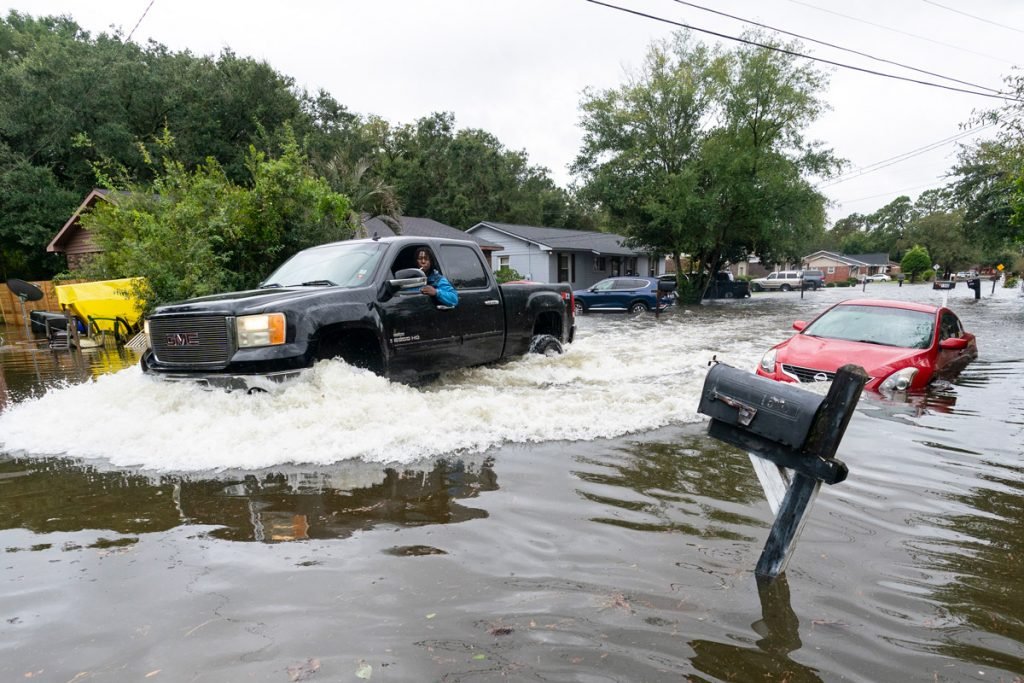[ad_1]
Besides leaving a path of death and destruction in its wake, Hurricane Ian has another legacy: Catastrophic flooding potentially damaged more than 350,000 vehicles, according to new estimates from Carfax.
Car shoppers need to be aware that these waterlogged vehicles will soon be showing up — in disguise — all over the country. Some shady used car lots (imagine that!) will illegally try to hide these flood-damaged vehicles by obtaining new titles for them, passing them off as pristine.
“Cosmetically these cars might look great, but if you don’t know what to look for, it’s nearly impossible to tell they’re literally rotting from the inside out,” Carfax spokeswoman Emilie Voss said in a press release. “Flood water can cause mechanical, electrical, health and safety issues in a vehicle, even if it was submerged for only a short time.”
Inevitably, thousands and thousands of these cars will be resold to unsuspecting buyers, like the roughly 400,000 flood-damaged cars that Carfax estimates are currently on the road — mostly from other recent hurricanes.
How can you protect yourself if you’re buying a used car? Don’t worry, we’ve got your back.
Contents
Flood-Damaged Vehicles: Not Just a Southern Problem
This isn’t just a problem in southeastern states that typically get hit by hurricanes.
Texas and Florida — hurricane magnets — lead the nation when it comes to the number of flood-damaged cars on the road. But Carfax finds that these vehicles also show up in states where hurricane flooding isn’t exactly an issue.
Carfax’s data shows these 10 states have the most flood-damaged autos:
States With the Most Flood-Damaged Autos
| State | Flood-Damaged Vehicles |
|---|---|
| Texas | 67,000 |
| Florida | 33,500 |
| Kentucky | 26,000 |
| Pennsylvania | 21,500 |
| New Jersey | 18,800 |
| North Carolina | 15,600 |
| New York | 14,600 |
| California | 14,200 |
| Illinois | 13,300 |
| Michigan | 11,400 |
Many of these flooded cars are the legacy of Hurricanes Harvey and Irma, which hit Texas and Florida in 2017; and Hurricane Ida, which hit Louisiana in 2021 but also caused massive flash flooding throughout the Northeast.
After Ida passed through, New Jersey and New York saw the biggest one-year spikes in the number of flood-damaged cars, according to Carfax.
How to Avoid Buying a Flood-Damaged Used Car
We rounded up helpful tips from Carfax, the auto inventory website Edmunds and other experts to help you avoid purchasing a vehicle that’s been damaged by flood waters.
Buy From a Reputable Dealer
To avoid being swindled into purchasing a flood-damaged used car, your safest bet is to buy from a trusted dealership. These dealers have a reputation to uphold and will likely provide you with a detailed vehicle history report.
Get a Vehicle History Report
We highly recommend getting a Carfax vehicle history report if you suspect flood damage.
A vehicle history report will include tons of relevant information, like states in which the car has been registered. Edmunds also recommends a cheap ($7 or less) report from the National Motor Vehicle Title Information System, which will detail whether the car has been salvaged, among other key points.
You should also use the National Insurance Crime Bureau’s VINCheck service to compare a used car’s VIN against a database of cars that have been totaled (including due to flood damage).
At carfax.com/flood, Carmax has a free “Flood Check” tool where you can simply type in the car’s VIN. It also has a flood damage checklist and a national map that shows where flooded cars are washing up.
Trust Your Senses, but Also a Mechanic’s
When you’re inspecting a used car, watch out for these red flags:
- Foul odors, particularly mold and mildew. These smells can signal that a car has been in standing water for a prolonged amount of time.
- Discolored carpeting or rusted metal. Stains in carpeting or seat fabrics are also indicators of standing water. Rust on the body or the undercarriage is a sign of excessive water exposure, particularly in newer cars.
- Inexplicable dirt build-up, like in the trunk or along the seat tracks. This is a sign that mud got into places where muddy feet typically do not travel.
- Water build-up in headlights and taillights. Fogginess in the lighting can also be a sign of prolonged water exposure.
- Mismatching parts, like seat materials compared to floor mats. A clever seller may replace a damaged floor mat, hoping you won’t notice that it isn’t a perfect match to the other mats or the seat fabric.
As an added precaution, have a trusted mechanic give the vehicle a once-over before you sign on the dotted line. Avoid any seller who’s uncomfortable with you taking the car to a mechanic.
If you do suspect a dealership or private seller of knowingly selling a flood-damaged vehicle, contact your local authorities or the National Insurance Crime Bureau.
Follow These Tips Every Time
When it comes to used cars, all of this is actually good lifelong advice. Hurricanes Harvey, Irma, Ida and Ian have put hundreds of thousands of flood-damaged vehicles into our nation’s used car lots and onto our roads.
From the looks of things, they won’t be the last major hurricanes to threaten the U.S. this decade. Global warming and all that.
But especially if you’re buying a used vehicle in the next year or so, be on the alert for flooded-out cars.
Mike Brassfield ([email protected]) is a senior writer at The Penny Hoarder. Freelance writer Timothy Moore contributed to this article.
[ad_2]

